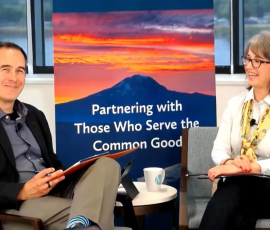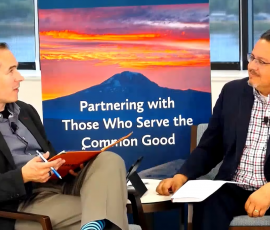Instructions for Completing Strategic Projects Grant Administration Forms
Strategic Projects grant administration Instructions
Intro
Congratulations on receiving a strategic project grant from the M.J. Murdock Charitable Trust! Once a grant has been awarded, several reports must be submitted to ensure it is executed successfully. The intent of the process and the purpose of each report is to help you demonstrate that you have executed the grant in a manner that is consistent with the Grant Agreement and the specific goals outlined in your application for the project. Furthermore, it is an opportunity to identify specific learnings that arise from all aspects of the project including planning, implementation, and initial outcomes.
Each grant must have a contact in Fluxx who is responsible for tracking the grant expenditures and preparing the reports. If this individual changes, please provide updated information to fluxx@murdocktrust.org.
Below you will find descriptions and instructions for completing reports and requesting payments.
Grant Agreements
The Grant Agreement (GA) will provide detailed information about what has been awarded, the conditions of the grant, projected payment schedule, and reporting requirements based on your project, budget, and the timing of your need for funds. It will be emailed first via DocuSign to your organization’s executive director (ED)/chief executive officer (CEO) and then to the board chair/officer. The ED/CEO and board chair/officer should carefully read, sign, and finish the GA DocuSign steps. Once processed, a copy of your GA will show in your grants portal. For more information about the GA, please watch our Grant Agreement video.
Definitions
Payment Types
Payments are initially scheduled to correspond with the status of the project, conditions expected to be met, and Trust practices. Typically, the Trust holds the funds until the grantee is ready to expend them.
- Outright Grant Payments: awards without specific conditions
- Outright—An outright payment is a full or partial payment that may be made upon the return of the signed GA. If funds are not immediately needed, a future payment may be requested based on the timing of your need for funds.
- Up To—An up to payment enables the Trust to avoid overfunding the project. To receive payment, the grantee must demonstrate the amount needed to complete the project.
- Contingent Grant Payments: awards with specific conditions
- Matching—A matching payment requires the grantee to raise a sum for the project as outlined in the GA.
- Top-Off—A top-off payment is intended to be the last sum of money needed to complete all aspects of the project. It is contingent upon completing the project as proposed and obtaining the balance of funds required to complete funding.
Report Types
Reports document the progress made on a project and demonstrate eligibility for payments.
- Progress Report (PR) is used to report progress, changes, etc., and may be used to request a payment.
- Conditions Met Report (CMR) is used to report satisfactory fulfillment of a contingency, match, top-off, etc. by the contingency deadline, and may be used to request a payment.
- Final Report (FR) is a required report that demonstrates how funds were used, highlights project outcomes, and officially closes the grant.
- Project Update Report (PUR) is available upon request to your program director. The PUR may be used to relay information about critical changes or updates to the organization, its leadership, or the project.
Types of Grants
Strategic projects grants are capacity-building awards for mission-focused projects and infrastructure investment, including staff and program grants, capital grants, and equipment and technology grants. Each type of grant may have different reporting and payment structures.
Staff and Program Grants
The Murdock Trust funds both new programs and the expansion of existing programs and may cover start-up costs and/or related new staff members. Typically, we fund program and staff grants on a declining basis over three years (100/67/33 percent).
Typically, staff and program grants are paid out through both outright and contingent payments over three years, beginning with the new hire or when the new or expanded program commences. The tentative due dates of progress reports for outright payments will change to reflect the new hire’s start date. The final two payments are contingent and correspond with the grant contingencies.
Let’s use a staff grant as an example. As soon as you’ve hired the new staff member, you’ll submit a progress report to communicate about the new hire and the progress that’s been made on the grant, to request your first of three outright payments (noted as a lump sum in the GA Tentative Payment Schedule). A progress report must be submitted for each outright payment. Once you’ve met a condition of the grant, you’ll submit a conditions met report to communicate that you have met the condition of the grant by its deadline.
Capital Grants
Capital grants support construction, renovation, land purchase, and other capital projects.
Typically, capital grants are paid out in one or more of the following ways: an outright portion, a matching portion, or a top-off contingency. Outright portions are usually tentatively scheduled for immediate payout, while matching portions and top-off contingencies are scheduled with payment dates well into the future to give the organization time to complete the stated condition. However, when the condition is met, a payment may be requested, even if it is before the posted due date.
Let’s use a construction project as an example. Often, these have an outright portion and a top-off contingent portion. The outright payment may be made upon receipt of the signed GA or by submitting a progress report. Once the project has been completed as proposed and the balance of funds has been obtained or matched to complete project funding, the conditions met report will be submitted to request the top-off contingent portion.
Equipment and Technology Grants
Equipment and technology grants support healthy organizational infrastructure through equipment and technology. The Murdock Trust may fund as much as 50 percent of the purchase cost.
Equipment and technology grants are paid out in one or more of the following ways: outright, up to, or top-off contingency. Some payments are scheduled well into the future to give the organization time to secure funding and complete the project. When conditions are met, a payment may be requested, even if it is before the posted due date.
Let’s use an equipment grant as an example. Often, these have an outright portion and a top-off contingent portion. The outright payment may be made upon receipt of the signed GA or by submitting a progress report. Once the project has been completed as proposed and the balance of funds has been obtained or matched to complete project funding, the conditions met report will be submitted to request the top-off contingent portion.
Report Instructions
When you are ready to fill out a report or request a payment, be sure to watch our Submitting Reports and Requesting Payments video. It walks you through how to navigate the grants portal and correctly submit reports and request payments. The following information will guide you through completing and submitting required reports.
General Instructions
Before completing reports, please reference your Grant Agreement and your approved project budget. These documents can be found in your grants portal under Grants – Active and by scrolling down to the Grant Agreement and Project Documents sections of your grant record.
- Reports Due—You will find your reports in the Reports Due section of your Grants portal.
- Editing—Click the Edit button in the top right corner of the Grants portal.
- Saving and Submitting—While you are working on your report, you may save and return to the report later. When it is complete, click the Submit button (not the Update button). At this point, the report status will change to Under Review, and the report will move to the Submitted Reports section of your Grants portal.
- Report Review—Trust staff will verify the information provided and schedule a payment if appropriate. If additional information or clarification is needed, you will receive instructions by email and the report will return to your Grants portal in the Revisions Requested section.
- Payments—Reports should be submitted at the beginning of the month in the Grants portal to allow time for processing. You will receive an email notification when your report has been approved. Payments are sent at the end of each month.
The reports below will be populated in your Grants portal. It is the responsibility of the grantee to complete and submit reports by the due date or when a payment is requested.
Progress Reports
The Progress Report (PR) is used to report progress, changes, etc., and is used to request an outright or up to payment. PRs will have suggested due dates that may shift during the life of a grant, depending on the progress of the project.
Please complete the following:
- Summary Narrative—Provide a brief narrative of your project’s progress relative to the goals or outcomes outlined in the proposal since the grant was awarded or the last report submitted. You are encouraged to succinctly offer successes, failures, surprises, challenges, and lessons learned to date. Brevity, accuracy, and candor are hallmarks of a good PR. Examples might include:
- a short description of the building construction or renovation, e.g., percent completion, timeline
- the status of the purchase of equipment, e.g., date an order was made, specifics on the item ordered and the manufacturer, timeline for delivery, installation, etc.
- the status of a new staff person, e.g., the name of the person hired, start date, the development of materials
- and/or the implementation of a new or expanded program
- Payment Request—The total grant awarded, the total project cost, and the amount of Trust grant funds received to date will auto-populate. Please provide the payment amount requested. For up to grants, once the final project costs are known, the remaining eligible portion of the up to amount can be requested.
- Budget & Other Documents—Attach a comparative budget of the project using the approved project budget. Use a spreadsheet to report line item by line item:
- the approved project budget
- the actual costs of the project
- how Trust funds were applied
- the balance of unspent funds
The comparative budget is key to the payment request. It should clearly describe how Trust grant funds have been used and how any unexpended funds will be used in the future. Be sure to review the sample relevant to your grant type:
Conditions Met Reports
If any conditions were placed on the grant—such as a match requirement, contingency, or a specific reporting expectation—a Conditions Met Report (CMR) must be submitted ahead of or by the due date to demonstrate how the condition was met. A CMR may be used to request a payment when the stated conditions have been met. Even if funds are not being requested, the CMR must be submitted by the deadline; these dates are firm and cannot be modified or extended without special permission. If you are unable to meet a CMR due date, please contact your program director.
For matching contingencies, the match must be satisfied with cash, pledges, and sometimes in-kind goods and services that are applied to the project. If earned revenues may be used to meet the condition, the words “internal or external to the organization” will be included in the award language in the GA. The starting date for the match is the award date. Examples:
- in a 1:1 match of $50,000, Murdock will make a $50,000 grant payment when the grantee has raised $50,000
- in a 1:2 match of $50,000, Murdock will make a $50,000 grant payment when the grantee has raised $100,000
For top-off contingencies, the Trust considers a project complete when purchase or work (construction, renovation, etc.) is done and all final expenses are known. Project completion is based on completing the project as proposed, identifying all the associated costs, and securing sufficient funds to cover all those costs (including the amount of the Trust’s award); it is not based on securing a pre-determined fundraising goal or the amount of the project budget as presented in the application. Funding for the project may be any combination of cash, pledges, in-kind goods and services, and/or debt.
Please complete the following:
- Summary Narrative—State the condition placed on the grant and provide a brief narrative of the source of funds used to meet the condition. Some examples:
- 3 donors gave gifts of over $10,000, 15 gave gifts of over $2,500, and 40 gave gifts of over $1,000, etc.
- provide similar data by source (board members, individuals, foundations, corporations, churches, institutional funds, debt, etc.); always provide other foundation grants by name and amount
The goal will often be obtained with a combination of contributed income (outright, pledged, and in-kind) and earned income. Be sure to provide a good accounting of all revenue sources, including organizational reserves and external debt. We do not need copies of pledges or names of donors, but we expect them to be available upon request.
- Payment Request—If payment is warranted as a result of meeting a condition of the grant, complete this section, including a brief project update since the last payment was received. Attach a comparative budget of the project using the approved project budget. Use a spreadsheet to report line item by line item:
- the approved project budget
- the actual costs of the project
- how Trust funds were applied
- the balance of unspent funds
The budget should reflect all known costs to date and the entire amount of the Trust award. The budget and presentation of how grant dollars will be or have been used is the key to the payment request. Using the comparative budget, clearly describe how Trust grant funds have been used and how any unexpended funds will be used in the future. Be sure to review the sample relevant to your grant type:
Final Reports
The Final Report (FR) is to be used to report and celebrate the results of the project and initiate the closing of the file. As soon as all Trust grant funds have been expended—usually no later than a year following your final grant payment—the organization is required to submit an FR. Once the FR is received and approved, the organization will receive final confirmation, and the grant record will be officially closed.
Please complete the following:
- Summary Narrative—Provide a brief narrative of:
- the time frame of your project
- the goals and outcomes as measured against your objectives outlined in your proposal
- the impact it has or will have upon your organization
- what you learned along the way
- what went well and what did not go as expected or planned
- a summary of the project budget and expenses
- how the project will be continued and supported going forward
- how this process might affect future projects undertaken by your organization
- Budget—The budget should reflect all costs and the entire amount of the Trust award. Referencing the budget that was presented with the proposal (or a later approved revision), clearly describe how Trust grant funds have been used. See examples below:
We appreciate the time you take to submit the FR. Your input will help educate and inform the Trust’s staff and provide insights for future grantmaking practices. Because most of the Trust’s time is spent with organizations before and during a grant application process, it is difficult for staff to attend formal celebrations, building dedications, etc. However, the Trust wants to know about your celebration plans.
Questions
If you have any questions as you go through the reporting process, please visit our website at murdocktrust.org. If you click on the Grant Opportunities page, you will see an expandable section called Grants Administration & Reporting Resources. Here you will find helpful instructions and samples for completing your grant reports. If you have questions, please email grantreports@murdocktrust.org.








